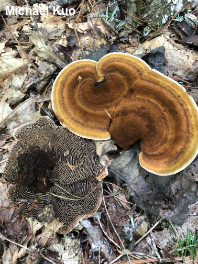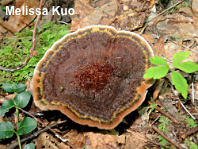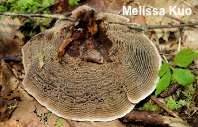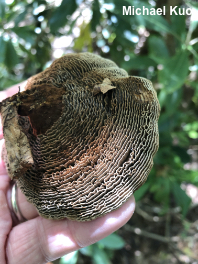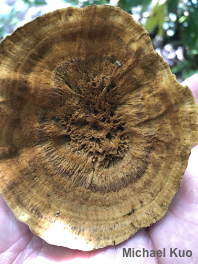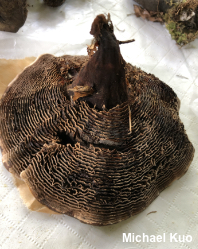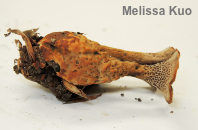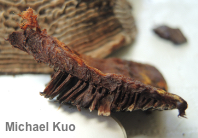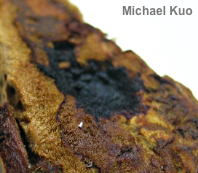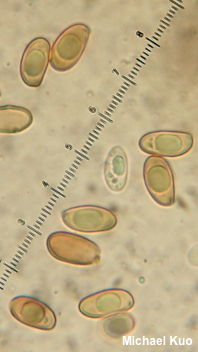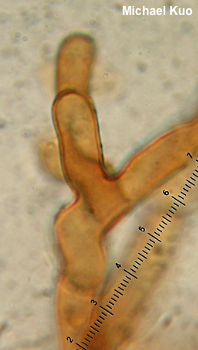| Major Groups > Polypores > Coltricia montagnei |

|
Coltricia montagnei [ Basidiomycetes > Hymenochaetales > Hymenochaetaceae > Coltricia . . . ] by Michael Kuo This thing is pretty amazing. It's a polypore, but it develops gills. Not only that, but the gills are concentric, rather than radiating out from the stem in lines! From above Coltricia montagnei looks like several "normal polypores" (an Inonotus, or a small, older, lonely specimen of Phaeolus schweinitzii), with a velvety surface featuring concentric zones of color. It even looks like other species of Coltricia from above—though it is much larger than Coltricia cinnamomea, the best-known Coltricia. Flip the mushroom over, however, and its fascinating concentric gills (the official term is "cyclomycoid tubes") are quite a surprise. Thanks to Walt Sturgeon for collecting Coltricia montagnei; his collection is deposited in The Herbarium of Michael Kuo. Thanks to Sherwood Forest Friends for facilitating collection of specimens. Description: Ecology: Apparently saprobic; growing terrestrially, alone or gregariously under hardwoods or conifers; widely distributed east of the Rocky Mountains but more common in the southern Appalachians than elsewhere; summer and fall. The illustrated and described collections are from Ohio and North Carolina. Cap: 3–12 cm wide; occasionally fused with other caps; dry; finely velvety to matted-woolly; concentrically zoned with shades of brown and orangish brown, often with yellow zones toward the margin and, when young, a white to pale yellowish or orangish marginal edge; in age becoming more brown overall, with fewer orangish or yellowish shades. Pore Surface: Poroid when young and occasionally poroid or partly poroid when mature; pores 1–2 mm across, angular, yellowish brown to orangish brown, bruising darker brown. Gills: Developing with maturity; concentrically arranged; thick; wavy; sometimes cross-veined; dull orangish brown to tan, sometimes bruising darker brown. Stem: 2–8 cm long; 1–2 cm thick; tapered to a pinched base; velvety; dark brown; sometimes substantially reduced so that, from above, the mushroom appears stem-less. Flesh: Tough; rusty brown. Chemical Reactions: KOH black on flesh, pore surface, and cap. Spore Print: Brown. Microscopic Features: Spores 10–13 x 5–6.5 µm; more or less ellipsoid; smooth; brownish-orangish to dark orange-brown in KOH; walls about 1 µm thick; dextrinoid. Cystidia, setae not found. Hyphal system monomitic; contextual hyphae 5–15 µm thick, smooth, orange-brown in KOH, walls to 1 µm thick; often branching at about 90 degrees. REFERENCES: (Fries, 1836) Murrill, 1920. (Smith, Smith & Weber, 1981; Arora, 1986; Gilbertson & Ryvarden, 1986; Phillips, 1991/2005; Lincoff, 1992; Barron, 1999; Roody, 2003; McNeil, 2006.) Herb. Kuo 07181507, 08091918. This site contains no information about the edibility or toxicity of mushrooms. |
© MushroomExpert.Com |
|
Cite this page as: Kuo, M. (2019, October). Coltricia montagnei. Retrieved from the MushroomExpert.Com Web site: http://www.mushroomexpert.com/coltricia_montagnei.html |
